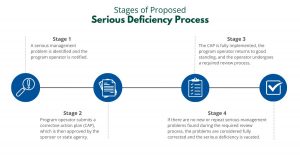Click HERE to subscribe to our NCA Policy and Advocacy eNews Group and select POLICY at the bottom of the form.
USDA released a memo that provides additional information regarding the provisions related to the frequency and number of reviews for State Agencies monitoring the CACFP.
USDA released a proposed rule for updating the Serious Deficiency process in the CACFP and SFSP. The rule proposes updates that would redefines serious deficiency, allows for full correction and removal of serious deficiencies, and extends the process to CACFP unaffiliated centers and SFSP sponsors.
USDA released a memo providing information state agencies need to conduct the FY 2024 reallocation of State Administrative Expense (SAE) funds in the child nutrition programs (CNPs).
USDA released CACFP guidance for state agencies on changes to SAE funds and how they are tracked and reported.
USDA released guidance that extends the option of serving commercially prepared tofu and soy yogurt as meat alternates to infants 6-11 months participating in the CACFP. The memo also extends the ability to serve tofu and soy yogurt as meat alternates in SFSP.





